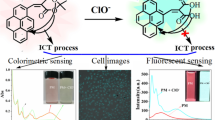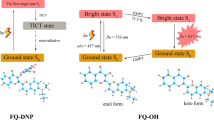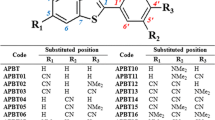Abstract
The hypochlorite (hypochlorite acid) produced in biological chlorine ions can resist various pathogens in the innate immune system, so it is important to design and detect the concentration of hypochlorite acid in the biological system. 2-(Benzo[d]thiazol-2-yl)-4- (methylthio) phenol (BTMSP), a fluorescent probe with large Stokes shifts, has been proposed a ESIPT-ICT dual mechanism in the experiment. But after the reaction, a new compound, BTMTP, does not have excited state intramolecular proton transfer (ESIPT) and intramolecular charge transfer (ICT) characters. In order to study the mechanism of the fluorescence probe BTMSP in detail, we have performed density functional theory (DFT) and time-dependent density functional theory (TDDFT) calculation. By computing, in the ground state, the BTMSP has the ICT process, and the BTMTP molecules are able to undergo intramolecular proton transfer reactions. The frontier molecular orbital (FMO) calculations show that the BTMSP has a large Stokes shift by ICT reaction and ESIPT coupling leading to the fluorescence emission red-shift. Although BTMTP does not have ICT character, it can undergo ESIPT reaction, causing Stokes shift decreasing.







Similar content being viewed by others
References
Wang X, Nakamoto T, Dulińska-Molak I, Kawazoe N, Chen G (2016) Regulating the stemness of mesenchymal stem cells by tuning micropattern features. J Mater Chem B 4:37–45. https://doi.org/10.1039/C5TB02215K
Yang Y-K, Cho HJ, Lee J, Shin I, Tae J (2009) A Rhodamine−hydroxamic acid-based fluorescent probe for hypochlorous acid and its applications to biological imagings. Org Lett 11:859–861. https://doi.org/10.1021/ol802822t
Chen X, Wang F, Hyun JY, Wei T, Qiang J, Ren X, Shin I, Yoon J (2016) Recent progress in the development of fluorescent, luminescent and colorimetric probes for detection of reactive oxygen and nitrogen species. Chem Soc Rev 45:2976–3016. https://doi.org/10.1039/C6CS00192K
Dong H, Zhou Y, Zhao L, Hao Y, Zhang Y, Ye B, Xu M (2020) Dual-response ratiometric electrochemical microsensor for effective simultaneous monitoring of hypochlorous acid and ascorbic acid in human body fluids. Anal Chem 92:15079–15086. https://doi.org/10.1021/acs.analchem.0c03089
Adam LC, Gordon G (1995) Direct and sequential potentiometric determination of hypochlorite, chlorite, and chlorate ions when hypochlorite ion is present in large excess. Anal. Chem. 67:535–540. https://doi.org/10.1021/ac00099a009
Thiagarajan S, Wu Z-Y, Chen S-M (2011) Amperometric determination of sodium hypochlorite at poly MnTAPP-nano Au film modified electrode. J Electroanal Chem 661:322–328. https://doi.org/10.1016/j.jelechem.2011.08.009
Pan S, Deen MJ, Ghosh R (2015) Low-cost graphite-based free chlorine sensor. Anal Chem 87:10734–10737. https://doi.org/10.1021/acs.analchem.5b03164
Wang W, Zhang L, Li L, Tian Y (2016) A single nanoprobe for ratiometric imaging and biosensing of hypochlorite and glutathione in live cells using surface-enhanced Raman scattering. Anal Chem 88:9518–9523. https://doi.org/10.1021/acs.analchem.6b02081
Zhou Y, Li J-Y, Chu K-H, Liu K, Yao C, Li J-Y (2012) Fluorescence turn-on detection of hypochlorous acid via HOCl-promoted dihydrofluorescein-ether oxidation and its application in vivo. Chem Commun 48:4677. https://doi.org/10.1039/c2cc30265a
Zhang D (2010) Highly selective and sensitive colorimetric probes for hypochlorite anion based on azo derivatives. Spectrochim Acta Part A Mol Biomol Spectrosc 77:397–401. https://doi.org/10.1016/j.saa.2010.05.028
Wu G, Zeng F, Wu S (2013) A water-soluble and specific BODIPY-based fluorescent probe for hypochlorite detection and cell imaging. Anal Methods 5:5589. https://doi.org/10.1039/c3ay41268g
Lu L, Zhang J, Yang X (2013) Simple and selective colorimetric detection of hypochlorite based on anti-aggregation of gold nanoparticles. Sens Actuators, B Chem 184:189–195. https://doi.org/10.1016/j.snb.2013.04.073
Wu L, Wu I-C, DuFort CC, Carlson MA, Wu X, Chen L, Kuo C-T, Qin Y, Yu J, Hingorani SR, Chiu DT (2017) Photostable ratiometric pdot probe for in vitro and in vivo imaging of hypochlorous acid. J Am Chem Soc 139:6911–6918. https://doi.org/10.1021/jacs.7b01545
Chen L, Park SJ, Wu D, Kim HM, Yoon J (2018) A two-photon ESIPT based fluorescence probe for specific detection of hypochlorite. Dyes Pigm 158:526–532. https://doi.org/10.1016/j.dyepig.2018.01.027
Cerón MR, Izquierdo M, Alegret N, Valdez JA, Rodríguez-Fortea A, Olmstead MM, Balch AL, Poblet JM, Echegoyen L (2016) Reactivity differences of Sc3 N@C2n (2n = 68 and 80). Synthesis of the first methanofullerene derivatives of Sc3 N@D5h -C80. Chem. Commun. 52:64–67. https://doi.org/10.1039/C5CC07416A
Ren H, Huo F, Yin C (2021) An ESIPT-based colorimetric and fluorescent probe with large Stokes shift for the sensitive detection of hypochlorous acid and its bioimaging in cells. New J Chem 45:4724–4728. https://doi.org/10.1039/D0NJ05807F
Zhong X, Yang Q, Chen Y, Jiang Y, Wang B, Shen J (2019) A mitochondria-targeted fluorescent probe based on coumarin–pyridine derivatives for hypochlorite imaging in living cells and zebrafish. J Mater Chem B 7:7332–7337. https://doi.org/10.1039/C9TB01948K
Pan Y, Huang J, Han Y (2017) A new ESIPT-based fluorescent probe for highly selective and sensitive detection of HClO in aqueous solution. Tetrahedron Letters. 58:1301–1304. https://doi.org/10.1016/j.tetlet.2017.02.043
Jiang G, Tang Z, Han H, Ding J, Zhou P (2021) Effects of intermolecular hydrogen bonding and solvation on enol-keto tautomerism and photophysics of azomethine–BODIPY dyads. J Phys Chem B 125:9296–9303. https://doi.org/10.1021/acs.jpcb.1c04776
Zhao J, Ji S, Chen Y, Guo H, Yang P (2012) Excited state intramolecular proton transfer (ESIPT): from principal photophysics to the development of new chromophores and applications in fluorescent molecular probes and luminescent materials. Phys Chem Chem Phys 14:8803–8817. https://doi.org/10.1039/C2CP23144A
Iijima T, Momotake A, Shinohara Y, Sato T, Nishimura Y, Arai T (2010) Excited-state intramolecular proton transfer of naphthalene-fused 2-(2′-Hydroxyaryl)benzazole family. J Phys Chem A 114:1603–1609. https://doi.org/10.1021/jp904370t
Liu B, Wang H, Wang T, Bao Y, Du F, Tian J, Li Q, Bai R (2012) A new ratiometric ESIPT sensor for detection of palladium species in aqueous solution. Chem Commun 48:2867. https://doi.org/10.1039/c2cc17677g
Murale DP, Kim H, Choi WS, Churchill DG (2013) Highly selective excited state intramolecular proton transfer (ESIPT)-based superoxide probing. Org Lett 15:3946–3949. https://doi.org/10.1021/ol4017222
Tang Z, Zhou P (2020) New insights into the excited state dynamics of quinoline-pyrazole isomerism. J Phys Chem B 124:3400–3407. https://doi.org/10.1021/acs.jpcb.0c01624
Tang Z, Wang Y, Bao D, Lv M, Yang Y, Tian J, Dong L (2017) Theoretical investigation of an excited-state intramolecular proton-transfer mechanism for an asymmetric structure of 3,7-dihydroxy-4-oxo-2-phenyl-4 H -chromene-8-carbaldehyde: single or double? J Phys Chem A 121:8807–8814. https://doi.org/10.1021/acs.jpca.7b08266
Gao M, Yu F, Lv C, Choo J, Chen L (2017) Fluorescent chemical probes for accurate tumor diagnosis and targeting therapy. Chem Soc Rev 46:2237–2271. https://doi.org/10.1039/C6CS00908E
Sinkeldam RW, Greco NJ, Tor Y (2010) Fluorescent analogs of biomolecular building blocks: design, properties, and applications. Chem Rev 110:2579–2619. https://doi.org/10.1021/cr900301e
Catalán J, Valle JCD, Fabero F, Garcia NA (1995) THE influence of molecular conformation on the stability of ultraviolet stabilizers toward direct and dye-sensitized photoirradiation: the case of 2-(2’-Hydroxy-5’-Methyphenyl)Benzotriazole (TIN P). Photochem Photobiol 61:118–123. https://doi.org/10.1111/j.1751-1097.1995.tb03949.x
Chou P-T, Martinez ML, Studer SL (1991) The design of an effective “Fluorescence Filter” for Raman spectroscopy. Appl Spectrosc 45:918–921. https://doi.org/10.1366/0003702914336589
Lou Z, Li P, Han K (2015) Redox-responsive fluorescent probes with different design strategies. Acc Chem Res 48:1358–1368. https://doi.org/10.1021/acs.accounts.5b00009
Cui Y, Li P, Wang J, Song P, Xia L (2015) An investigation of excited-state intramolecular proton transfer mechanism of new chromophore. JAMS. 6:23–33. https://doi.org/10.4208/jams.100314.010115a
Lim S-J, Seo J, Park SY (2006) Photochromic switching of excited-state intramolecular proton-transfer (ESIPT) fluorescence: a unique route to high-contrast memory switching and nondestructive readout. J Am Chem Soc 128:14542–14547. https://doi.org/10.1021/ja0637604
Tang K-C, Chang M-J, Lin T-Y, Pan H-A, Fang T-C, Chen K-Y, Hung W-Y, Hsu Y-H, Chou P-T (2011) Fine tuning the energetics of excited-state intramolecular proton transfer (ESIPT): white light generation in a single ESIPT system. J Am Chem Soc 133:17738–17745. https://doi.org/10.1021/ja2062693
Kwon JE, Park SY (2011) Advanced organic optoelectronic materials: harnessing excited-state intramolecular proton transfer (ESIPT) process. Adv Mater 23:3615–3642. https://doi.org/10.1002/adma.201102046
Hsieh C-C, Jiang C-M, Chou P-T (2010) Recent experimental advances on excited-state intramolecular proton coupled electron transfer reaction. Acc Chem Res 43:1364–1374. https://doi.org/10.1021/ar1000499
Liu Y-H, Lan S-C, Zhu C, Lin S-H (2015) Intersystem crossing pathway in quinoline-pyrazole isomerism: a time-dependent density functional theory study on excited-state intramolecular proton transfer. J Phys Chem A 119:6269–6274. https://doi.org/10.1021/acs.jpca.5b03557
Shen Y, Liu X, Zhang X, Zhang Y, Gu B (2020) Employing an ICT-ESIPT strategy for ratiometric tracking of HClO based on sulfide oxidation reaction. Spectrochim Acta Part A Mol Biomol Spectrosc 239:118515. https://doi.org/10.1016/j.saa.2020.118515
Feller D (1996) The role of databases in support of computational chemistry calculations. J Comput Chem 17:1571–1586. https://doi.org/10.1002/(SICI)1096-987X(199610)17:13%3c1571::AID-JCC9%3e3.0.CO;2-P
Tang Z, Bai T, Zhou P (2020) Sensing mechanism of a fluorescent probe for cysteine: photoinduced electron transfer and invalidity of excited-state intramolecular proton transfer. J Phys Chem A 124:6920–6927. https://doi.org/10.1021/acs.jpca.0c06171
Schäfer A, Horn H, Ahlrichs R (1992) Fully optimized contracted Gaussian basis sets for atoms Li to Kr. J Chem Phys 97:2571–2577. https://doi.org/10.1063/1.463096
Cancès E, Mennucci B, Tomasi J (1997) A new integral equation formalism for the polarizable continuum model: Theoretical background and applications to isotropic and anisotropic dielectrics. J Chem Phys 107:3032–3041. https://doi.org/10.1063/1.474659
Cammi R, Tomasi J (1995) Remarks on the use of the apparent surface charges (ASC) methods in solvation problems: Iterative versus matrix-inversion procedures and the renormalization of the apparent charges. J Comput Chem 16:1449–1458. https://doi.org/10.1002/jcc.540161202
Zhan H, Wang Y, Li Z, Tang Z, Tian J, Fei X (2021) Investigating the influence of electronic effects of functional groups on the fluorescence mechanism of probes in water samples. J Phys Chem A 125:2866–2875. https://doi.org/10.1021/acs.jpca.1c00108
Frisch MJ, Trucks GW, Schlegel HB, Scuseria GE, Robb MA, Cheeseman JR, Scalmani G, Barone V, Petersson GA, Nakatsuji H, Li X, Caricato M, Marenich AV, Bloino J, Janesko BG, Gomperts R, Mennucci B, Hratchian HP, Ortiz JV, Izmaylov AF, Sonnenberg JL, Williams-Young D, Ding F, Lipparini F, Egidi F, Goings J, Peng B, Petrone A, Henderson T, . Ranasinghe D, Zakrzewski VG, Gao J, Rega N, Zheng G, Liang W, Hada M, Ehara M, Toyota K, Fukuda R, Hasegawa J, Ishida M, Nakajima T, Honda Y, Kitao O, Nakai H, Vreven T, Throssell K, Montgomery Jr. JA, Peralta JE, Ogliaro F, Bearpark MJ, Heyd JJ, Brothers EN, Kudin KN, Staroverov VN, Keith TA, Kobayashi R, Normand J, Raghavachari K, Rendell AP, Burant JC, Iyengar SS, Tomasi J, Cossi M, Millam JM, Klene M, Adamo C, Cammi R, Ochterski JW, Martin RL, Morokuma K, Farkas O, Foresman JB, Fox DJ, Gaussian 16 Rev. C.01, Wallingford, CT, 2016.
Johnson ER, Keinan S, Mori-Sánchez P, Contreras-García J, Cohen AJ, Yang W (2010) Revealing noncovalent interactions. J Am Chem Soc 132:6498–6506. https://doi.org/10.1021/ja100936w
Lu T, Chen F (2012) Multiwfn: A multifunctional wavefunction analyzer. J Comput Chem 33:580–592. https://doi.org/10.1002/jcc.22885
Humphrey W, Dalke A, Schulten K (1996) VMD: Visual molecular dynamics. J Mol Graph 14:33–38. https://doi.org/10.1016/0263-7855(96)00018-5
Tang W, Sanville E, Henkelman G (2009) A grid-based Bader analysis algorithm without lattice bias. J. Phys. Condens. Matter. 21:084204. https://doi.org/10.1088/0953-8984/21/8/084204
Acknowledgements
This work was supported by Basis Research Project of Department of Education of Liaoning Province (Grant J2019020), the Open Project of SKLMRD (the open fund of the state key laboratory of molecular reaction dynamics in DICP, CAS) and the General Program from Education department of Liaoning Province (Grant LJKZ0534).
Author information
Authors and Affiliations
Corresponding author
Additional information
Publisher's Note
Springer Nature remains neutral with regard to jurisdictional claims in published maps and institutional affiliations.
Supplementary Information
Below is the link to the electronic supplementary material.
Rights and permissions
Springer Nature or its licensor holds exclusive rights to this article under a publishing agreement with the author(s) or other rightsholder(s); author self-archiving of the accepted manuscript version of this article is solely governed by the terms of such publishing agreement and applicable law.
About this article
Cite this article
Dai, M., Zhang, P., Tang, Z. et al. The fluorescence mechanism of a probe based on benzothiazole group to detect HClO. Theor Chem Acc 141, 57 (2022). https://doi.org/10.1007/s00214-022-02919-0
Received:
Accepted:
Published:
DOI: https://doi.org/10.1007/s00214-022-02919-0




